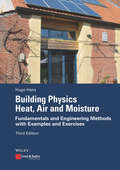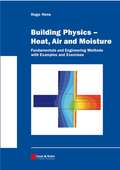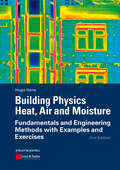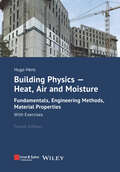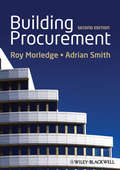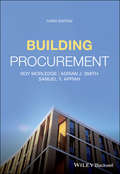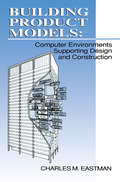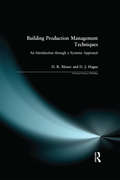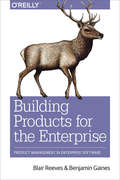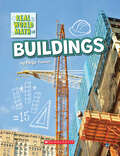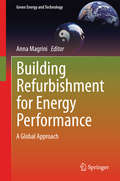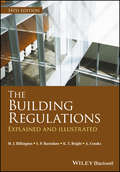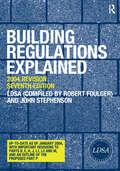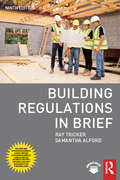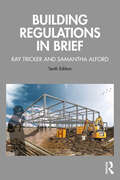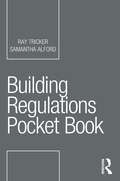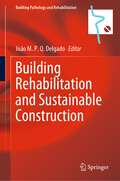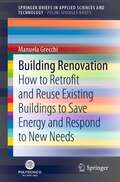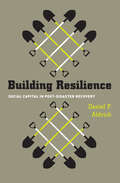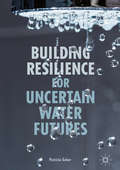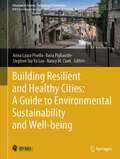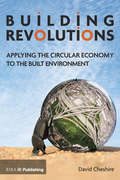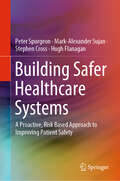- Table View
- List View
Building Physics - Heat, Air and Moisture: Fundamentals and Engineering Methods with Examples and Exercises
by Hugo S. HensBad experiences with construction quality, the energy crises of 1973 and 1979, complaints about "sick buildings", thermal, acoustical, visual and olfactory discomfort, the need for good air quality, the move towards more sustainability - all these have accelerated the development of a field that, for a long time, was hardly more than an academic exercise: building physics (in English speaking countries sometimes referred to as building science). The discipline embraces domains such as heat and mass transfer, building acoustics, lighting, indoor environmental quality and energy efficiency. In some countries, fire safety is also included. Through the application of physical knowledge and its combination with information coming from other disciplines, the field helps to understand the physical phenomena governing building parts, building envelope, whole buildings and built environment performance, although for the last the wording "urban physics" is used. Today, building physics has become a key player on the road to a performance based building design. The book deals with the description, analysis and modeling of heat, air and moisture transport in building assemblies and whole buildings with main emphasis on the building engineering applications, including examples. The physical transport processes determine the performance of the building envelope and may influence the serviceability of the structure and the whole building. Compared to the second edition, in this third edition the text has partially been revised and extended.
Building Physics -- Heat, Air and Moisture: Fundamentals and Engineering Methods with Examples and Exercises
by Hugo S. HensBad experiences with construction quality, the energy crises of 1973 and 1979, complaints about 'sick buildings', thermal, acoustical, visual and olfactory discomfort, the move towards more sustainability, have all accelerated the development of a field, which until 35 years ago was hardly more than an academic exercise: building physics. Through the application of existing physical knowledge and the combination with information coming from other disciplines, the field helps to understand the physical performance of building parts, buildings and the built environment, and translates it into correct design and construction. This book is the result of thirty years teaching, research and consultancy activity of the author. The book discusses the theory behind the heat and mass transport in and through building components. Steady and non steady state heat conduction, heat convection and thermal radiation are discussed in depth, followed by typical building-related thermal concepts such as reference temperatures, surface film coefficients, the thermal transmissivity, the solar transmissivity, thermal bridging and the periodic thermal properties. Water vapour and water vapour flow and moisture flow in and through building materials and building components is analyzed in depth, mixed up with several engineering concepts which allow a first order analysis of phenomena such as the vapour balance, the mold, mildew and dust mites risk, surface condensation, sorption, capillary suction, rain absorption and drying. In a last section, heat and mass transfer are combined into one overall model staying closest to the real hygrothermal response of building components, as observed in field experiments. The book combines the theory of heat and mass transfer with typical building engineering applications. The line from theory to application is dressed in a correct and clear way. In the theory, oversimplification is avoided. This book is the result of thirty years teaching, research and consultancy activity of the author.
Building Physics - Heat, Air and Moisture: Fundamentals and Engineering Methods with Examples and Exercises
by Hugo S. HensBad experiences with construction quality, the energy crises of 1973 and 1979, complaints about 'sick buildings', thermal, acoustical, visual and olfactory discomfort, the need for good air quality, the move towards more sustainability, all have accelerated the development of a field, which until some 40 years ago was hardly more than an academic exercise: building physics. Building physics combines several knowledge domains such as heat and mass transfer, building acoustics, lighting, indoor environmental quality and energy efficiency. In some countries, also fire safety is included. Through the application of existing physical knowledge and the combination with information coming from other disciplines, the field helps to understand the physical phenomena governing assembly, building envelope, whole building and built environment performance, although for the last the wording "urban physics" is used. Building physics has a true impact on performance based building design. This volume focuses on heat, air, moisture transfer and its usage in building engineering applications.
Building Physics - Heat, Air and Moisture: Fundamentals, Engineering Methods, Material Properties and Exercises
by Hugo S. HensBad experiences with construction quality, the energy crises of 1973 and 1979, complaints about "sick buildings", thermal, acoustical, visual and olfactory discomfort, the need for good air quality, the move towards energy efficiency, decarbonization and sustainability ? all these have accelerated the development of a discipline that, for a long time, was hardly more than an academic exercise: building physics. The discipline embraces domains such as heat and mass transfer, building acoustics, lighting, indoor environmental quality, energy efficiency, and, in some countries, fire safety. Through the application of physical knowledge and its combination with information coming from other disciplines, building physics helps to under-stand the physical phenomena governing building parts, building envelope, whole building and built environment performance ? called urban physics. Today, building physics has be-come a key player on the road to highly performing new buildings and renovations. This book deals with heat, air and moisture transport in building parts or assemblies and whole buildings with emphasis on the building engineering applications. Compared to the third edition, this fourth edition has been expanded in chapter 1 to include the physical determination of the thermal conductivity of materials, together with an in-depth discussion of all the effects of thicker insulation layers. In chapter 2, additional information has been added on wind pressure and the evaluation of condensation inside the building com-ponents, while a new chapter 4 on material properties has been included. The whole book, including the figures, has been revised and restructured where necessary.
Building Physics - Heat, Air and Moisture: Fundamentals and Engineering Methods with Examplesand Exercises
by Hugo S. HensBad experiences with construction quality, the energy crises of 1973 and 1979, complaints about 'sick buildings', thermal, acoustical, visual and olfactory discomfort, the need for good air quality, the move towards more sustainability, all have accelerated the development of a field, which until some 40 years ago was hardly more than an academic exercise: building physics.Building physics combines several knowledge domains such as heat and mass transfer, building acoustics, lighting, indoor environmental quality and energy efficiency. In some countries, also fire safety is included. Through the application of existing physical knowledge and the combination with information coming from other disciplines, the field helps to understand the physical phenomena governing assembly, building envelope, whole building and built environment performance, although for the last the wording `urban physics? is used. Building physics has a true impact on performance based building design.This volume focuses on heat, air, moisture transfer and its usage in building engineering applications.
Building Procurement
by Roy Morledge Adrian J. SmithAs an industrial process, construction is unique in that the method of procurement of any built asset (building, infrastructure or process plant) defines many of the subsequent management processes that take place during the building phase – a very different situation to the purchase of goods and services in most other industries. The procurement process is therefore central to the success of any construction project and many of the problems which impact construction projects can be traced back to the procurement phase, so a good understanding of the methods of procurement and the influence it has on project success is essential for all those working in the industry. Much has changed in the global construction industry since publication of the first edition of Building Procurement, for example the global liquidity & banking crisis and the debt burden of many major economies. This new edition has been rewritten to take account of these significant developments, but at its core it continues to provide a critical examination and review of current procurement practices in the UK, continental Europe (including EU procurement procedures), China and the USA. It retains its original strong emphasis on the need for clients to establish achievable objectives which reflect the project business case and focuses on development of suitable strategies and management structures to meet those objectives in the current construction climate. Building Procurement will be essential reading for senior undergraduate and postgraduate students of construction management and practitioners working in all areas of construction management. Review of the first edition "...a thorough and comprehensive investigation of building procurement..." Construction Management and Economics
Building Procurement
by Roy Morledge Adrian J. Smith Samuel Y. AppiahAs an industrial process, construction is unique. The procurement processes used to achieve the successful completion of built assets requires a different approach to that adopted in most other industries, due to the design of buildings being bespoke and the sites being geographically varied. The procurement process is central to the success of any construction project and many of the problems which impact construction projects can be traced back to the procurement phase, so a good understanding of the methods of procurement, the development of a procurement strategy and the influence it has on project success is essential for all those working in the industry. Much has changed in the global construction industry since publication of the second edition of Building Procurement, for example the increase in debt burden of many major economies, widespread adoption of Building Information Modelling (BIM) Technology in the industry and the United Kingdom's exit from the European Union. This new edition has been rewritten to take account of these significant developments, but at its core it continues to provide a critical examination and review of current procurement practices in the UK, continental Europe (including EU procurement procedures), China, Middle East and Sub-Saharan Africa and the USA. It retains its original strong emphasis on the need for clients to establish achievable objectives which reflect the project business case and focuses on development of suitable strategies and management structures to meet those objectives in the current construction climate. Building Procurement will be essential reading for senior undergraduate and postgraduate students of construction management and practitioners working in all areas of construction management.
Building Product Models: Computer Environments, Supporting Design and Construction
by Charles M EastmanBuilding Product Models thoroughly presents the concepts, technology, and methods now used to work out what will become the building product model - a new, digital representation for architecture, civil engineering, and building construction.Organized into three sections (history, current tools and concepts, and existing efforts and research issues), this resource provides the field of building product modeling with a standard reference as well as a single, comprehensive text for university courses. Until now, all the efforts in building modeling have been reported in research journals and conference proceedings or been made available as draft standards on the Internet. Building Product Models is the only book available on this vital field, bringing together essential aspects of major efforts from the early 1970s to the present.
Building Production Management Techniques: An Introduction through a Systems Approach (Chartered Institute of Building)
by David R. Moore Douglas J. HagueBuilding Production Management Techniques provides an innovative approach to dealing with the universal problems of time, cost and quality of construction projects. The book provides an introduction to a number of management techniques that can be applied to the problems of production presented by the diverse, heavy, large and geographically distributed products typical of construction everywhere. As well as recognised and tried and tested management techniques, the authors have introduced a number of techniques which may not have been considered by the construction industry to date.
Building Products for the Enterprise: Product Management in Enterprise Software
by Blair Reeves Benjamin GainesIf you’re new to software product management or just want to learn more about it, there’s plenty of advice available—but most of it is geared toward consumer products. Creating high-quality software for the enterprise involves a much different set of challenges. In this practical book, two expert product managers provide straightforward guidance for people looking to join the thriving enterprise market.Authors Blair Reeves and Benjamin Gaines explain critical differences between enterprise and consumer products, and deliver strategies for overcoming challenges when building for the enterprise. You’ll learn how to cultivate knowledge of your organization, the products you build, and the industry you serve.Explore why:Identifying customer vs user problems is an enterprise project manager’s main challengeEffective collaboration requires in-depth knowledge of the organizationAnalyzing data is key to understanding why users buy and retain your productHaving experience in the industry you’re building products for is valuableProduct longevity depends on knowing where the industry is headed
Building (Real World Math)
by Paige TowlerGrab your hard hat and get ready to use math to learn all about buildings!1 skyscraper … 2 houses … 3 castles—the world is full of buildings! Architects use math every day to design buildings. Join a real architect on an amazing adventure to recognize SHAPES, discover PATTERNS, COMPARE skyscraper sizes, and more. Then test your math skills with special You Can Do It challenges.This brand-new series demonstrates how math skills can be applied to high-interest topics and careers in Coding, Building, Tracking Animals, and Space Exploration. The K-2 math concepts include counting 1-100 with basic addition and subtraction, using the power of 10, measuring, and simple geometry. Real world scientists, architects, programmers, and mathematicians model hands-on, from-the-field experiences in a way that will make children excited to use and expand their math skills!
Building Refurbishment for Energy Performance: A Global Approach (Green Energy and Technology)
by Anna MagriniIn Europe, the building sector accounts for 40% of energy consumption which has a strong influence on greenhouse gas emissions. The book deals with efficient methodologies aimed to reduce greenhouse gas emissions in the building sector. This includes analyses of the building envelopes, the heating systems, the use of solar energy and the assessment of the environmental and energy sustainability of the proposed solutions. After a brief introduction to the physical fundamentals involved in the study, results are presented to support cost-effective technical strategies to promote actions for energy saving, in the most critical fields and with the most economic advantage.
The Building Regulations: Explained and Illustrated
by A. Crooks K. T. Bright M. J. Billington S. P. BarnshawSince publication of the first edition in 1976, The Building Regulations: Explained and Illustrated has provided a detailed, authoritative, highly illustrated and accessible guide to the regulations that must be adhered to when constructing, altering or extending a building in England and Wales. This latest edition has been fully revised throughout. Much of the content has been completely rewritten to cover the substantial changes to the Regulations since publication of the 13th edition, to ensure it continues to provide the detailed guidance needed by all those concerned with building work, including architects, building control officers, Approved Inspectors, Competent Persons, building surveyors, engineers, contractors and students in the relevant disciplines.
Building Regulations Explained
by London District Surveyors Association John StephensonAlmost all buildings erected or altered in England and Wales must satisfy the requirements of the building regulations. This essential reference has been revised in line with new legislation up to January 2004, including important revisions to Parts B, E, H, J, L1, L2, and M and an outline of the proposed Part P.Each chapter explains in clear terms the appropriate regulation and any other legislation, before explaining the approved document. The Appeals and Determinations have been repositioned at the end of each chapter. Publications lists and relevant sources of information are also included, together with annexes devoted to legislation relevant to the construction industry, determinations made by the Secretary of State, and sample check lists.This highly illustrated and practical approach to the subject makes this the indispensable, one-stop reference guide for professionals and students.
Building Regulations in Brief
by Ray Tricker Samantha AlfordThis ninth edition of the most popular and trusted guide reflects all the latest amendments to the Building Regulations, planning permission and the Approved Documents in England and Wales. This includes coverage of the new Approved Document Q on security, and a second part to Approved Document M which divides the regulations for 'dwellings' and 'buildings other than dwellings'. A new chapter has been added to incorporate these changes and to make the book more user friendly. Giving practical information throughout on how to work with (and within) the Regulations, this book enables compliance in the simplest and most cost-effective manner possible. The no-nonsense approach of Building Regulations in Brief cuts through any confusion and explains the meaning of the Regulations. Consequently, it has become a favourite for anyone in the building industry or studying, as well as those planning to have work carried out on their home.
Building Regulations in Brief
by Ray Tricker Samantha AlfordThis tenth edition of the most popular and trusted guide reflects all the latest amendments to the Building Regulations, planning permission and the Approved Documents in England and Wales. This includes coverage of the recent changes to use classes, updated sections on planning permission, permitted development and application fees. We have included the revisions to Approved Document B (as a result of the Hackitt Review), as well as the latest changes to Approved Documents F and L, and the new documents O (overheating) and S (electric vehicle charging points), which come into effect in June 2022. Giving practical information throughout on how to work with (and within) the Regulations, this book enables compliance in the simplest and most cost-effective manner possible. The no-nonsense approach of Building Regulations in Brief cuts through any confusion and explains the meaning of the Regulations. Consequently, it has become a favourite for anyone working in or studying the building industry, as well as those planning to have work carried out on their home. It is essential reading for all building contractors and subcontractors, site engineers, building engineers, building control officers, building surveyors, architects, construction site managers and DIYers.
Building Regulations Pocket Book (Routledge Pocket Books)
by Ray Tricker Samantha AlfordThis handy guide provides you with all the information you need to comply with the UK Building Regulations and Approved Documents. On site, in the van, in the office, wherever you are, this is the book you’ll refer to time and time again to double check the regulations on your current job. The Building Regulations Pocket Book is the must have reliable and portable guide to compliance with the Building Regulations. Part 1 provides an overview of the Building Act Part 2 offers a handy guide to the dos and don’ts of gaining the Local Council’s approval for Planning Permission and Building Regulations Approval Part 3 presents an overview of the requirements of the Approved Documents associated with the Building Regulations Part 4 is an easy to read explanation of the essential requirements of the Building Regulations that any architect, builder or DIYer needs to know to keep their work safe and compliant on both domestic or non-domestic jobs This book is essential reading for all building contractors and sub-contractors, site engineers, building engineers, building control officers, building surveyors, architects, construction site managers and DIYers. Homeowners will also find it useful to understand what they are responsible for when they have work done on their home (ignorance of the regulations is no defence when it comes to compliance!).
Building Rehabilitation and Sustainable Construction (Building Pathology and Rehabilitation #23)
by João M. P. Q. DelgadoThis book provides a collection of recent research works related to building pathologies, recycled materials, case studies and practical advices on implementation of sustainable construction. It is divided in seven chapters that intend to be a resume of the current state of knowledge for benefit of professional colleagues, scientists, students, practitioners, lecturers and other interested parties to network. At the same time, these topics will be going to the encounter of a variety of scientific and engineering disciplines, such as civil, mechanical and materials engineering.
Building Renovation: How to Retrofit and Reuse Existing Buildings to Save Energy and Respond to New Needs (SpringerBriefs in Applied Sciences and Technology)
by Manuela GrecchiThis book reviews the building renovation process by systematizing the phases of analysis and prior knowledge through a project that not only considers energy savings but also thoroughly examines complex issues, such as defining the correct new functions and answers to new needs. The urgency of climate change and the many problems associated with the excessive use of energy are forcing a reorganization of the renovation process with an interest in reusing existing buildings with a more sustainable approach. The adaptive transformation of old buildings has become a dominant theme in many urban renewal projects. It must necessarily include strategies for energy efficiency, reduced pollutant emissions, improved environmental performance, economic sustainability and cultural identity. The examples selected are intended to provide evidence of good practices in the review and transformation of old buildings.
Building Resilience: Social Capital in Post-Disaster Recovery
by Daniel P. AldrichThe factor that makes some communities rebound quickly from disasters while others fall apart: &“A fascinating book on an important topic.&”—E.L. Hirsch, in Choice Each year, natural disasters threaten the strength and stability of communities worldwide. Yet responses to the challenges of recovery vary greatly and in ways that aren&’t explained by the magnitude of the catastrophe or the amount of aid provided by national governments or the international community. The difference between resilience and disrepair, as Daniel P. Aldrich shows, lies in the depth of communities&’ social capital. Building Resilience highlights the critical role of social capital in the ability of a community to withstand disaster and rebuild both the infrastructure and the ties that are at the foundation of any community. Aldrich examines the post-disaster responses of four distinct communities—Tokyo following the 1923 earthquake, Kobe after the 1995 earthquake, Tamil Nadu after the 2004 Indian Ocean Tsunami, and New Orleans post-Katrina—and finds that those with robust social networks were better able to coordinate recovery. In addition to quickly disseminating information and financial and physical assistance, communities with an abundance of social capital were able to minimize the migration of people and valuable resources out of the area. With governments increasingly overstretched and natural disasters likely to increase in frequency and intensity, a thorough understanding of what contributes to efficient reconstruction is more important than ever. Building Resilience underscores a critical component of an effective response.
Building Resilience for Uncertain Water Futures
by Patricia GoberThis book describes the existential threats facing the global water systems from population growth and economic development, unsustainable use, environmental change, and weak and fragmented governance. It argues that ‘business-as-usual’ water science and management cannot solve global water problems because today’s water systems are increasingly complex and face uncertain future conditions. Instead, a more holistic, strategic, agile and publically engaged process of water decision making is needed.Building Resilience for Uncertain Water Futures emphasises the importance of adaptation through a series of case studies of cities, regions, and communities that have experimented with anticipatory policy-making, scenario development, and public engagement. By shifting perspective from an emphasis on management to one of adaptation, the book emphasizes the capacity to manage uncertainties, the need for cross-sector coordination, and mechanisms for engaging stakeholder with differing goals and conflict resolution. This book will be a useful resource for students and academics seeking a better understanding of sustainable water use, water policy and water resources management.
Building Resilient and Healthy Cities: A Guide to Environmental Sustainability and Well-being (Advances in Science, Technology & Innovation)
by Anna Laura Pisello Ilaria Pigliautile Stephen Siu Yu Lau Nancy M. ClarkThis book presents a number of research papers that discuss how green urbanism is connected to promoting healthier living conditions. This is to reduce the impact of environmental changes including climate change, depletion of the earth's resources, and the emergence of infectious diseases and pandemics on humans. Addressing these challenges, the book at hand offers strategies and solutions that enable designers to bring together knowledge about sustainable and comfortable urban built environments, with an emphasis on the correlation between architecture, engineering, and medical facets in regard to comfort and well-being. Thus, the book is of significant importance to architects interested in the science of the built environment, climate change, and human resilience. This book is a culmination of selected research papers from the first version of the international conference on "Health & Environmental Resilience and Livability in Cities (HERL) - The challenge of climate change" which was held online in 2022 in collaboration with the University of Perugia, Italy, and the fifth edition of the international conference on Green Urbanism (GU) which was held online in 2021 in collaboration with the University of Rome.
Building Resilient Neighbourhoods in Singapore: The Convergence of Policies, Research and Practice (Advances in 21st Century Human Settlements)
by Chan-Hoong Leong Lai-Choo Malone-LeeThis book examines how institutional and environmental features in neighbourhoods can contribute to social resilience, highlighting the related socio-demographic issues, as well as the infrastructure, planning, design and policies issues. It is divided into three themes – infrastructure, planning, and community. Infrastructure examines how physical features such as parks and street patterns influence neighborliness and resilience, while planning studies how urban design enhances social interactions. Lastly, community discusses policies that can forge social bonds, either through racial integration, grassroots activities, or social service. Overall, the book combines research and empirical work with scholarly models of resilience and governance philosophy, focusing on Singapore’s urban planning and social policies.
Building Revolutions: Applying the Circular Economy to the Built Environment
by David CheshireThe construction industry operates within a linear economy of make, use, dispose. Buildings are stripped out and torn down with astonishing regularity while new buildings are constructed from hard-won virgin materials. But raw materials are becoming scarce, and the demands for them are exploiting fragile ecosystems, even as the global demand for resources continues to rise. Policy makers and organisations are beginning to look for a more regenerative, circular economy model. The construction industry demands over half the world’s extracted materials and generates around a third of the total waste generated in the EU, making it a prime candidate for applying the circular economy. Yet there has been little focus on how construction industry professionals and their clients can contribute towards the movement. Drawing on illustrative methods and examples, Building Revolutions explains how the principles of a circular economy can be applied to the built environment where resources are kept in use and their value retained.
Building Safer Healthcare Systems: A Proactive, Risk Based Approach to Improving Patient Safety
by Peter Spurgeon Mark-Alexander Sujan Stephen Cross Hugh FlanaganThis book offers a new, practical approach to healthcare reform. Departing from the priorities applied in traditional approaches, it instead assesses – both theoretically and practically – the successful lessons learned in other safety-critical industries, and applies them to healthcare settings. The authors focus on the importance of human factors and performance measures to establish proactive, systematic methods for healthcare system design. This approach helps to identify potential hazards before accidents occur, enhancing patient safety. In addition, the book details the new approach on the basis of real-world applications in the NHS and insights from NHS staff. Case studies and results are presented, demonstrating the significant improvements that can be achieved in risk reduction and safety culture. Lastly, the book outlines what steps healthcare organisations need to take in order to successfully adopt this new approach. The approach and experiential learning is brought together through the development of a new holistic patient safety education syllabus.
